![]()
![]()
![]()
Use LEFT and RIGHT arrow keys to navigate between flashcards;
Use UP and DOWN arrow keys to flip the card;
H to show hint;
A reads text to speech;
33 Cards in this Set
- Front
- Back
- 3rd side (hint)
|
Congenital Heart Defects |
develops before birth, where one or more problems within the heart's structure changes the way blood flows through the heart & out to the body. with these heart problems less blood is pumped out of the heart resulting in dcreased cardiac output meaning Less oxygen-rich blood out to the body, resulting in the big complications like: abnormal heart rhythms murmurs heart failure hypoxia (low oxygen in blood) Risk factors: -Genetics: • Family history • Down Syndrome -During pregnancy: • Infection (Rubella) • Alcohol/Drug abuse • Diabetes |
types: Aortic valve stenosis Coarctation of the aorta Ebstein’s anomaly Patent ductus arteriosus Pulmonary valve stenosis Septal defects Single ventricle defects Tetralogy of Fallot Total anomalous venous pulmonary connection Transposition of the great arteries Truncus arteriosus |
|
|
heart defects complications Hypoxia RIGHT to left |
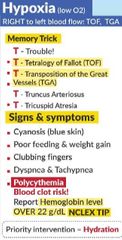
Q: primary reason for a newborn with congenital heart disease to be kept well-hydrated? •to reduce the risk of cerebrovascular accidents (CVA) Q: polycythemia...highest priority? •maintain adequate hydration |
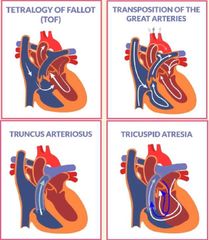
if it starts with T - then it’s trouble T - Tetralogy of Fallot (TOF) T - Transposition of the Great Vessels (TGA) these 2 are the most tested T - Truncus Arteriosus T - Tricuspid Atresia these are PRIORITY since low oxygen is always a priority on the NCLEX - as it's the MOST deadly! This hypoxia leads to blue babies, as these defects take blood away from the lungs & push blood from right to LEFT side of the heart. Report Hemoglobin level OVER 22 g/dL. This is PRIORITY & must be reported to the health care provider! Due to the hypoxia a lot of RBCs are created to compensate for this low O2. But - Instead of perfusing This thick viscous blood can easily clog tiny vessels & form a deadly blood clot, specifically in the tiny blood vessels within the brain - causing a delayed stroke! |
|
|
heart defects complications CHF LEFT to right |

|
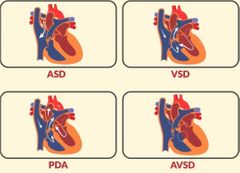
|
|
|
Obstructive Defects |
stenosis: Pulmonary & Aortic When blood flow attempts to leave the heart it meets resistance from this narrowed valve. This blocked blood flow now backs up in the heart - resulting in Decreased cardiac OUTput meaning Less oxygen-rich blood OUT to the body |
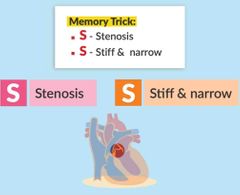
|
|
|
Types (RIGHT to left blood flow) |

|
|
|
|
TOF |
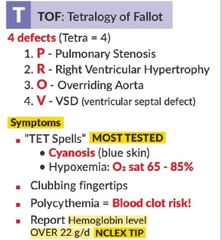
|
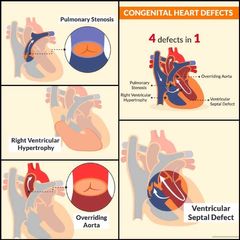
|
|
|
hypercyanotic nursing interventions |
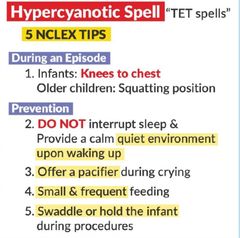
|
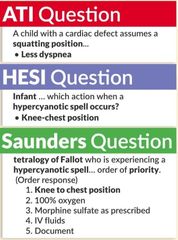
hypercyanotic spell usually occur during stress, crying, hunger, feeding, painful stimuli, upon waking up from nap or morning |
|
|
TGA Tricuspid Atresia Truncus arteriosus |
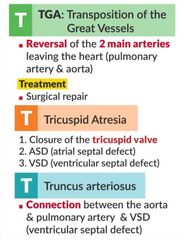
|

|
|
|
types of LEFT to right blood flow |
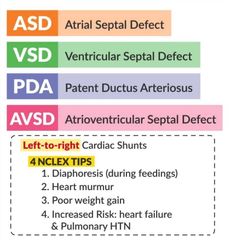
|

|
|
|
ASD VSD |

|
|
|
|
PDA AVSD |
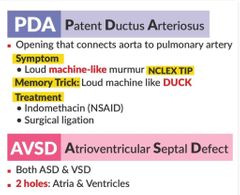
|
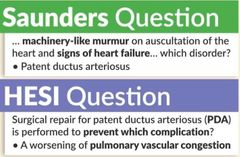
AVSD commonly seen in babies with down syndrome |
|
|
types of Obstructive Defects |
Pulmonic Aortic |
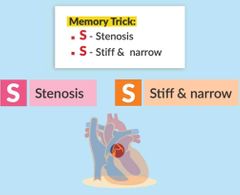
|
|
|
Pulmonic Stenosis |
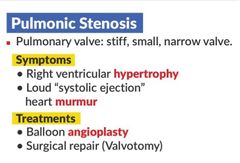
|
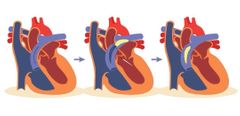
|
|
|
Aortic Stenosis |
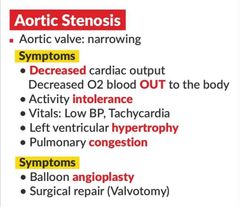
|
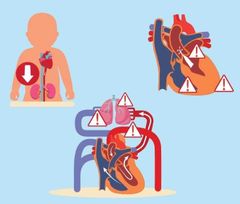
|
|
|
COA |

|
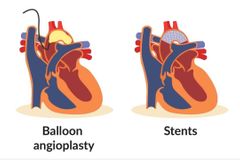
|
|
|
Chest Tube Monitoring |
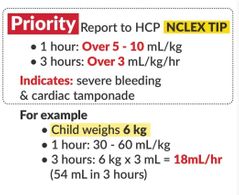
|
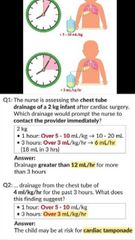
Chest tubes are placed during cardiac surgery to help drain excess fluid & air for lung expansion. After surgery it remains in place to drain excess blood. |
|
|
Post-Op Care & Teaching |
After surgery the nurse should always elevate the head of bed to reduce respiratory effort Surgical sites - infection! Report fever, warm surgical site, smelly purulent drainage & no heavy lifting or strenuous activity for the first 3 to 4 weeks. |
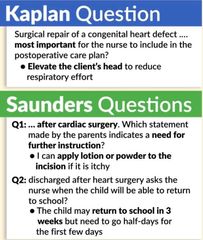
|
|
|
Rheumatic Fever |
Rheumatic Fever can result after NOT treating strep throat or scarlet fever correctly! For example, not finishing the antibiotics or just not treating the infection. The untreated infection causes total body inflammation (vessels, joints, brain,skin,heart), damaging the heart valves so clients will typically present with a heart murmur. |
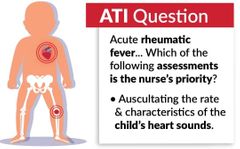
|
|
|
Rheumatic Fever Signs & Symptoms Labs |
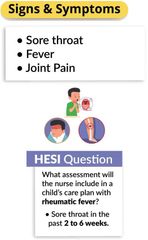
|
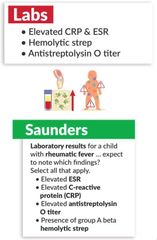
|
|
|
Rheumatic Fever treatment |

|
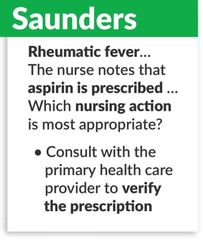
|
|
|
Kawasaki |
inflammation within the blood vessels, particularly the coronary arteries. It also affects lymph nodes, skin, mucous membranes. infants, young children, teens |

|
|
|
Kawasaki Signs & Symptoms Interventions |
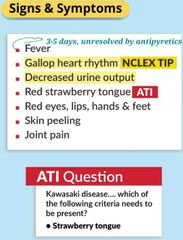
|

|
|
|
Kawasaki |
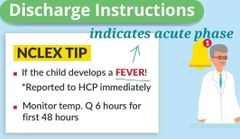
|
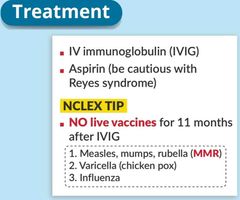
|
|
|
Heart Failure |

|
|
|
|
Heart failure signs |
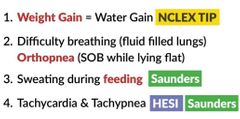
As the heart fails to pump blood forward, heavy fluid can back up into the lungs making it difficult to breathe during breast or bottle feedings! Fluid also backs up into the body resulting in WEIGHT GAIN from Water Gain. |
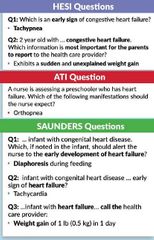
|
|
|
HF Causes |
Congenital heart disease or defects, are the BIGGEST CAUSE of heart failure in children. The child is born with 1 or more problems with the heart's structure that changes the way blood flows through the heart resulting in a backup of blood. |

|
|
|
HF Classic Manifestations |

|
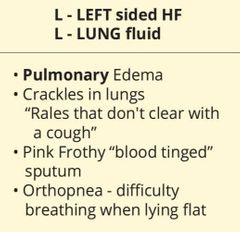
|
|
|
heart failure pharmacology |
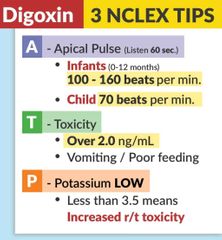
less than 100 beats per min hold the drug & check for toxicity vomit: Don't give another dose hold the drug & report to HCP immediately never double up if miss a dose |

#1 Tested Drug is Digoxin Children with heart failure, the heart is weak & having trouble pumping blood forward. Digoxin helps the heart for a Deep contraction! It is a cardiac glycoside that increases contractility within the heart. a more forceful heart pump, which PUSHES blood FORWARD, so that it does not back up into the lungs & or body! No more fluid filled lungs means breathing is easier! |
|

|
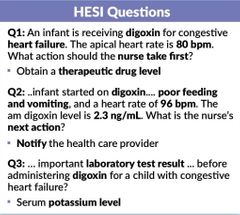
|
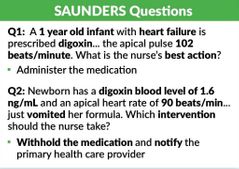
|
|

|

|
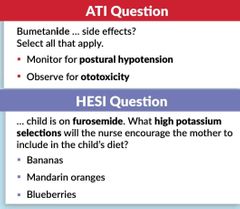
|
|
|
Interventions |

Give the child a lot of rest in order to take work load off the heart & decrease that cardiac demand! ▪︎Limit play time ▪︎Cluster the care for uninterrupted sleep |
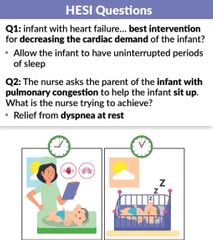
|
|
|
TOF |
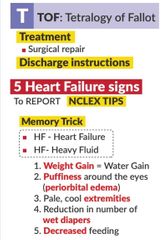
|
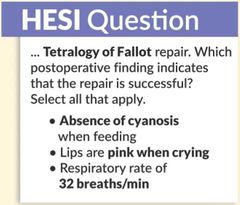
|
|
|
congenital heart defects Treatment |
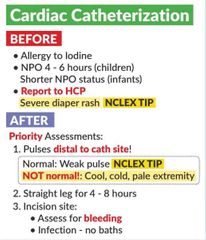
|
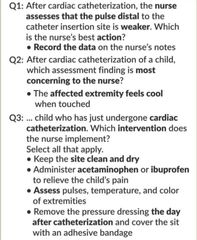
treatment include medications to lower BP and control HR, heart devices, cardiac catheter procedures. Surgery is the ultimate solution in most cases & serious cases may require a heart transplant. |

